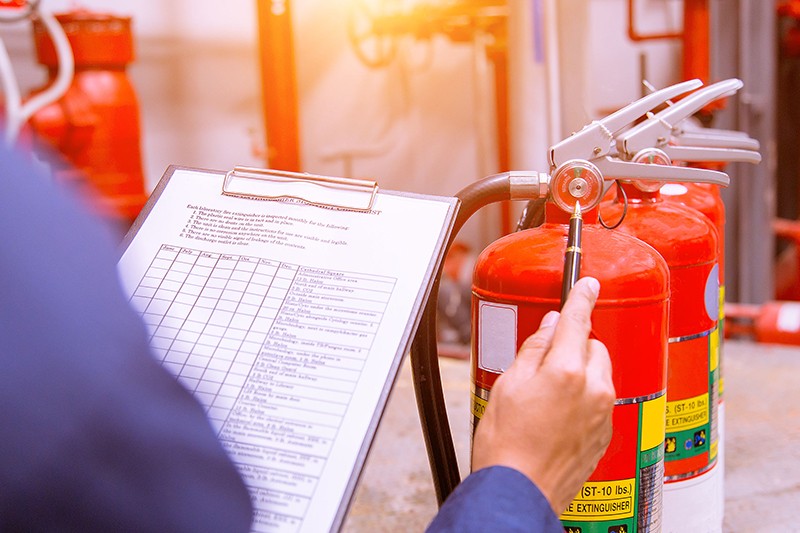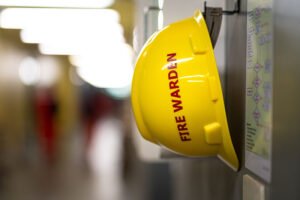FIRE SAFETY
An overview to appointing Responsible Persons in the workplace for fire safety
When it comes to appointing a responsible person for fire safety it’s important to fully understand their role. Dakota Murphey expands on what duties should be considered for the appointed person and understand the vital role they play in mitigating fire risks in the workplace.
The latest government statistics indicate that fires in non-residential settings are down 14% from the previous year.
So how much influence does a responsible person have in reducing the risk of fire?
Who is a responsible person?
Following the introduction of the Regulatory Reform (Fire Safety) Order which came into force in 2005, companies with five or more employees are required to undertake a fire risk assessment and appoint a responsible person. This ‘responsible person’ ensures that the company they own or work for has sufficient fire safety procedures in place.

Candidates for becoming a responsible person are typically company owners, building occupiers or landlords. The role is a vital one in the eyes of the law and failure to put the proper procedures in place by the responsible person can result in fines or even prison sentences.
Given how important a responsible person is, it’s not uncommon for companies to appoint more than one; commonly for businesses with large departments. Each appointed responsible person must communicate with their department regarding fire safety.
A responsible person’s principal duty is to look after the fire safety of the building or premises. There are a few different aspects of fire safety they must cover to ensure compliance with rules and regulations.
Fire safety training
A responsible person should put a fire safety training programme in place. This training programme will give every employee and person in the building the necessary information and understanding to deal with a fire. That might be to simply follow the evacuation process for the most part and, if they are fire marshals, to deal with any potential fires.
Fire prevention principles
A fire breaking out isn’t something anyone wants to happen in the workplace and it is the duty of the responsible person to ensure that it doesn’t happen. That is why they must ensure adequate fire prevention principles are in place to reduce the risk of a fire starting as much as possible.
The fire prevention principles include:
- Avoiding risks
- Evaluating risks where they cannot be avoided
- Replacing dangerous equipment with less or non-dangerous equipment
- Creating an overall prevention policy
- Collective prevention measures take priority over individual prevention measures
- Instructing all employees on fire prevention principles
Fire escape routes
Another key element of fire safety for the responsible person is to map out escape routes. These must not put employees at further risk and must be a clear passage through the premises. That means they cannot be obstructed and the responsible person or persons must ensure it stays that way.
A blockage along a fire route could be catastrophic and a failure of duty. Not only must the responsible person plan fire escape routes, but they should also determine a secure meeting point for employees.
Sometimes known as a ‘fire assembly point’, this is a safe location that regulations state needs to be at least 50ft from the premises. This could be across the road from your building or in the car park, but they ought to be clearly designated and with the appropriate signage.
Fire risk assessment
Regular risk assessments are essential for ensuring the safety of everyone in a building or premises, and are required under the Fire Safety Order. They are used to identify any potential fire hazards and to determine actions that need to be taken to reduce the risk. A qualified person should be employed to undertake the assessment.
Among other things, fire safety risk assessment should establish potential fire threats and those who are at higher risk (for example, anyone working with dangerous substances). The risk assessment is documented and includes an evaluation of the risk plus what was done to remove or reduce the chance of a fire occurring. As part of the risk assessment, it’s essential to also look at fire safety drill procedures and determine whether they are effective enough or if any improvements are possible.
Fire detection and prevention equipment
Detecting a fire as early as possible is the next line of defence if the preventative measures have failed.
To ensure this next level of defence can be relied upon, the responsible person must check that the correct firefighting and detecting equipment is adequately installed in the building. This includes establishing that fire extinguishers have not expired, and that the detection equipment works and is regularly serviced.
Is first aid part of a responsible person’s duties?
 While first aid isn’t necessarily part of a responsible person’s duties, the two are not mutually exclusive. It’s more than possible and makes sense for a responsible person to undertake first aid training, should they have sufficient time and energy for it. However, it’s good practice to split the role of responsible person and first aider up.
While first aid isn’t necessarily part of a responsible person’s duties, the two are not mutually exclusive. It’s more than possible and makes sense for a responsible person to undertake first aid training, should they have sufficient time and energy for it. However, it’s good practice to split the role of responsible person and first aider up.
The responsible person’s main focus in the event of a fire is to ensure everyone leaves the building safely and promptly. In the heat of the moment, they may not have the time to tend to any injured people so a separate first aid trained person would accommodate this role better.
Appointing competent persons
The responsible person is where the buck stops when it comes to fire safety but that doesn’t mean they have to be the only one responsible. One of the roles that fall to a responsible person is appointing competent persons.
A competent person is someone given appropriate and adequate training to assist a responsible person in their duties. This might include appointing a competent person, or persons, as fire wardens, for instance.
Fire wardens can work alongside the responsible person to establish the appropriate fire prevention protocols. Typically, it is the fire wardens who are most at risk if there is a fire in the building as it’s their responsibility to get everyone else out before themselves.
Building security
Besides fire safety, one other aspect of a responsible person’s role is building security. That means ensuring that the building’s fire safety equipment cannot be tampered with by any outside parties. Checking that fire escape routes are clear also falls under building security.
The responsible person must check the opening and closing of fire escapes to ensure they function perfectly, this includes automatic doors. Fire exit signs need to be checked to ensure they are visible and can remain so when the lights are off.
Checking building security also means staying on top of any changes to the building or building regulations. For instance, the recent Fire Safety Act 2021 brought changes to the role of a responsible person in the wake of the Grenfell tragedy in 2017.
Now, responsible persons must extend their checks to the building’s structure, external walls and any common parts. The external walls include doors or windows in those walls, and anything attached to the exterior of those walls, e.g. balconies and cladding.
Furthermore, all doors between the domestic premises and common parts must also be checked and maintained like they are part of the rest of the building.
Visit the gov.uk website for further advice and explanations of the fire safety responsibilities of responsible persons.
This article was originally published on IFSEC Global.
When you listen to this on-demand webinar, you will:
- Hear expert opinions about common definitions of competence and do they apply to fire safety management
- Explore the benefits of getting it right and the implications of getting it wrong
- Hear about what competence might look like and how to describe it
- Better understand when selecting internal and external fire risk assessors that the selection criteria is the same
- Hear how employers, clients and organisations senior and middle management can make the right choices and decisions concerning resourcing and appointing competent people such as the ‘Responsible Person’, Fire Risk Assessors’ and establishing a ‘Fire Risk Management Strategy’
Register now for Register now for: ‘How a ‘Responsible Person’ selects competent fire risk assessors and management support’
An overview to appointing Responsible Persons in the workplace for fire safety
When it comes to appointing a responsible person for fire safety it’s important to fully understand their role. Dakota Murphey expands on what duties should be considered for the appointed person and understand the vital role they play in mitigating fire risks in the workplace.
Dakota Murphey
SHP - Health and Safety News, Legislation, PPE, CPD and Resources Related Topics
Hundreds of workplace buildings to be inspected for safety this week
Legal insight: Common errors in fire safety
Tall Buildings High Rise Construction Fire Safety Conference call for papers



My understanding is that the Responsible Person is a legal ‘person’ and not an actual human with a pen. As stated in article, it WILL be employer, landlord or occupier. These are likely to be companies or organisations, not individuals. Obviously the RP will have to appoint actual humans to help ‘it’ to perform the RP responsibilities. What these people get called is optional, but the legal duty remains with the ‘RP’ (the corporate entity). Fire risk assessment is one specific duty which can be clearly allocated to a real human. Others can also be appointed to do other parts… Read more »